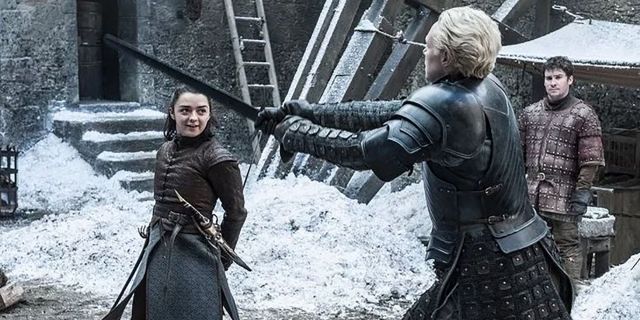Power lives and dies under several contingent circumstances in Game of Thrones. Most citizens of Westeros are born into their station, from which there is little escape. While one’s family name means everything in this franchise, other factors regularly affect their potential. Anyone born a girl, for example, must come to terms with the fact that they have far fewer options than their brothers. However, some ladies in Game of Thrones become warriors despite the cultural biases.
For all the fantasy elements, A Song of Ice and Fire faithfully represents life in the medieval period. It doesn’t canonically occur on Earth, but the franchise borrows endless details from history. Several historical cultural groups appear in the series with their names changed. Several events take inspiration from major changes. George R. R. Martin also included several cultural beliefs popular in that era, including the varied views of women’s place in the world.
Warrior Women in Westeros
Westeros has a long and proud tradition of women fighting in battles, but it remains outside the norm. The Seven Kingdoms don’t explicitly forbid women from becoming warriors but frown upon their “unladylike” choices. There is no path to knighthood for women. In its earliest days, Westeros saw Visenya and Rhaenys Targaryen, the sisters/wives of Aegon the Conqueror. Visenya wielded Dark Sister, her family’s Valyrian steel longsword, while riding her dragon into battle. While Rhaenys never carried a blade, she also commanded troops and rode a dragon. Though they kicked in the door and helped to conquer the continent, Visenya and Rhaenys didn’t create a culture of warrior women in Westeros. Future Targaryen women rarely raised weapons, preferring to become queens and commanders. Princess Nymeria of the Rhoyne also established her culture in Dorne, though she was more of a commander than a combatant. Dorne has more warrior women, but it remains outside the norm.
Brienne of Tarth, Arya Stark, and Asha Greyjoy are all daughters of noble dynasties who took up weapons instead of their usual destiny. Brienne was the lone heir of Lord Selwyn Tarth of the Everlands. Her siblings died young, prompting Selwyn to push Brienne into marriage, but she decided on a warrior’s life from childhood. Despite facing endless prejudice, Brienne overcame expectations to become the first woman to gain a knighthood in the Seven Kingdoms. Arya also developed an interest in swordplay early, prompting her father, Eddard Stark, to hire a Braavosi swordmaster to teach her his unique art. She would go on to become an assassin under the Faceless Men, practicing a more clandestine form of combat. Asha grew up as Balon Greyjoy’s unofficial heir, learning the ways of combat and diplomacy at his side. She’s a boisterous and confident lady, as skilled with her axes as any soldier in the army she commands. Her culture, the ironborn, is more permissive to warrior women. Here’s a short list of other cultures with similar views in Westeros:
- The North: Northern women are more likely to learn to defend themselves, given the harsh environment they grow up in. This likely contributed to Eddard Stark’s acquiescence to Arya’s wishes.
- Bear Island: This small land mass off the coast of the North demands combat skills from its women. As men are usually away fishing, ladies wield axes to fend off ironborn invaders.
- Dorne: Nymeria’s example isn’t totally ignored. Warrior women are more common in Dorne than in the rest of Westeros, but still far from the norm. Oberyn Martell’s daughters, the Sand Snakes, are a great example.
- Crannogmen: These swamp-dwellers seem to teach their daughters to hunt and fight as well as their sons. Meera Reed is the best example, known for wielding a spear and net.
Warrior Women in Essos

The old continent featured several cultures with warrior women. The local fighting pits sometimes feature ladies, including the respected champion, Barsena. The Yellow City features Malazza, the Girl General, who commands over 100 slave soldiers. The ancient Patrimony of Hyrkoon founded three fortress cities called Kayakayanaya, Shamyriana, and Bayasabhad. These cities armed warrior women who traditionally fought bare-chested, with pierced nipples and cheeks. A famous scribe once called them the greatest warriors in the world. The Kingdom of Sarnor became famous for chariot warfare, often led by women. Finally, the Jogos Nhai were warlike nomads who raised every child to fight. There are, by and large, more warrior women in Essos than in Westeros, thanks in large part to the influence of the Andal invasion.
Warrior Women Elsewhere

The Free Folk beyond the Wall have spearwives who train as warriors. Despite their name, many become archers or swordswomen. Harma the Dogshead is a brutal captain beyond the Wall. Their egalitarian approach takes Jon Snow by surprise, but it quickly proves itself superior to Westerosi hangups. The people of the Summer Isles celebrate many beautiful traditions, including warrior women. Their best examples include Kojja Mo, the daughter of the captain of the Cinnamon Wind. The impressive swan ship carries a detachment of sharpshooters called the red archers. The Summer Isles create goldenheart bows, thought to be the best in the world. Kojja is a master sharpshooter and the captain of the red archers. The inventor of the goldenheart bow and swan ship was a warrior princess called Xanda Qo, who unified the Summer Isles.
Women may regularly face cultural prejudice, but many become outstanding warriors. Game of Thrones features dozens of examples of all-powerful ladies in a variety of roles, but those who choose to take up arms face a unique uphill battle. From Visenya Targaryen to Xanda Qo, warrior women remain an integral part of the Known World, even if men refuse to accept them.











Leave a Reply